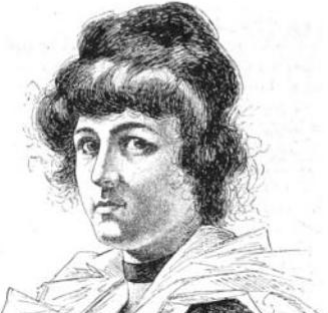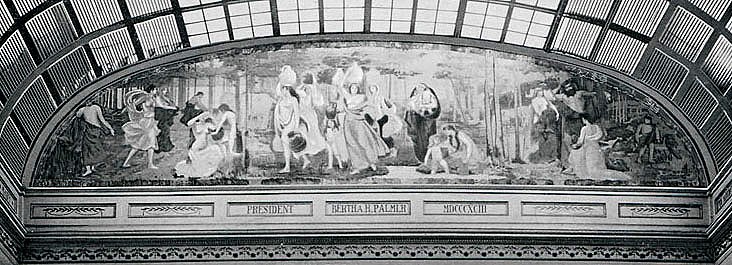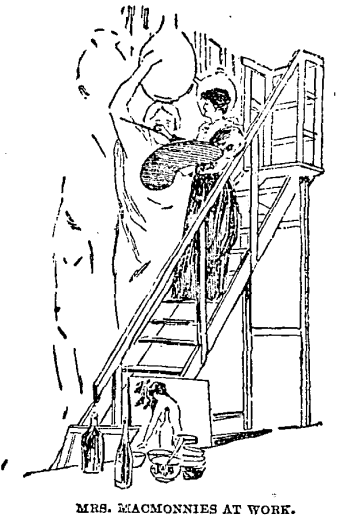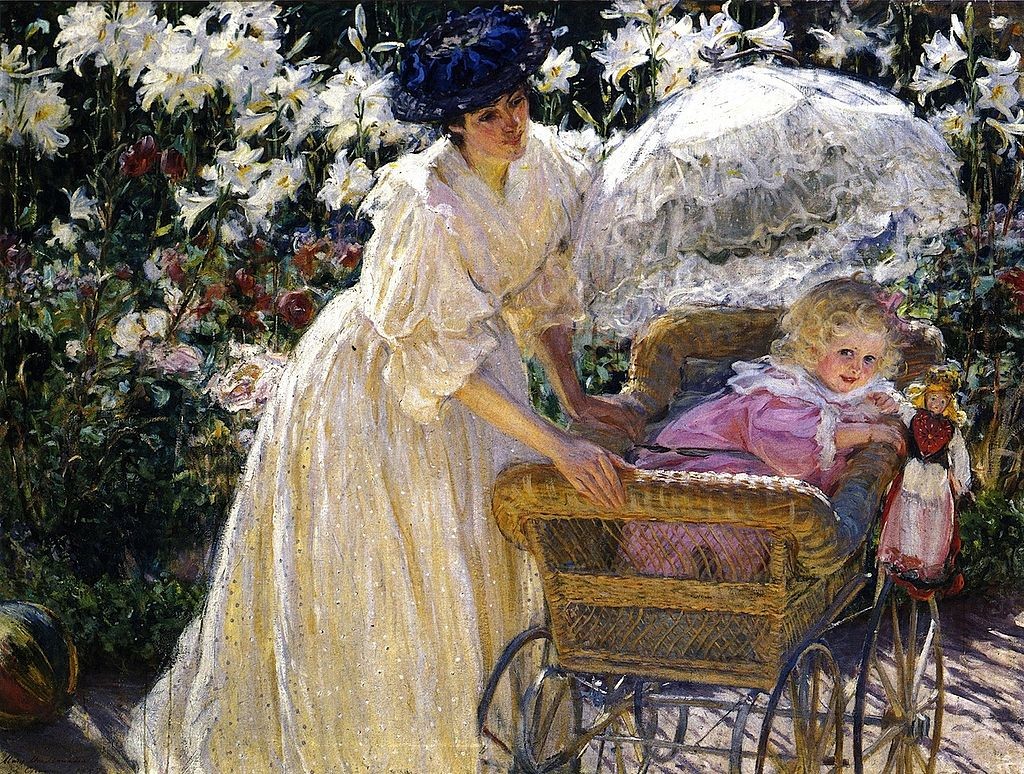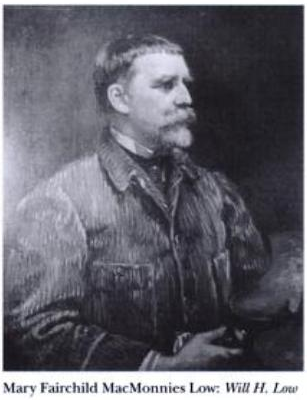Mary MacMonnies Low, 1858 – 1946
Born in New Haven, Connecticut in 1858 to a telegraph operator father and a miniature painter mother, Mary Louise Fairchild MacMonnies Low distinguished herself as a painter in the early 20th century. She also happened to be married to two prominent male artists over the course of her fascinating life. As a budding young artist, Mary Fairchild studied at the St. Louis School of Fine Arts alongside Cornelia Field Maury, and both women would go on to spend time at 4 rue de Chevreuse. In 1885, Fairchild won a three-year scholarship to study in Paris, where she enrolled in the Académie Julian and also received instruction from British painter Harry Thompson as well as master portraitist Carolus-Duran.
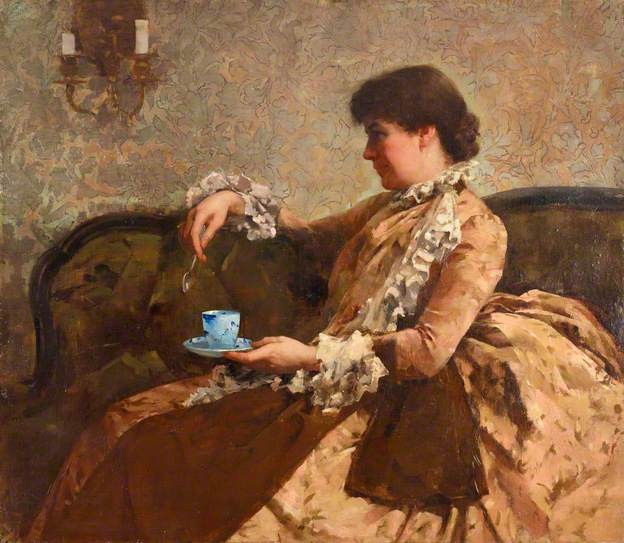
Shortly after arriving in Paris, Fairchild began exhibiting her work at the Salon des artistes français. Her first Salon entry was an 1886 portrait of her friend, art agent and curator Sarah Hallowell. The portrait is currently owned by Robinson College, University of Cambridge. Mary continued exhibiting at the Salon des artistes français and, beginning in 1904, in the Salon des Beaux Arts (she was eventually elected an Associate Member of the Societé nationale des Beaux-Arts).
Mary met Scottish-American sculptor Frederick MacMonnies in Paris in 1887 and the two married the following September (after scandalously sharing an art studio out of wedlock for nearly a year). They had two daughters and established a home in Giverny in 1898 but the marriage fell apart and they divorced in 1908. Just one year later, in November 1909, Mary married her longtime admirer, the widowed artist Will Hicok Low, and they returned to America with Mary's daughters in 1910, settling in Bronxville, New York for the rest of their lives.
Her good friend Sarah Hallowell proved instrumental in securing a breakthrough commission for Mary: the mural, "Primitive Women," which adorned one tympanum in the Women's Building of the 1893 World's Columbian Exposition in Chicago. Mary Cassatt, the most significant American woman artist in this period, painted a mural entitled "Modern Women" to adorn the tympanum opposite, enabling visitors to contrast imagined women at the dawn of civilization with modern women at the turn of the 20th century. The pairing of MacMonnies with a household name like Mary Cassatt gave an immense boost to her reputation as an artist in her own right, not merely the wife of the great Frederick MacMonnies. In an interview with fellow artist Eleanor E. Greatorex for Godey's Magazine, Mary described how she chose to depict her subject for the Women's Building:
I began immediately to study the composition, rejecting in turn the idea of the savage, the pre-historic, the slave, the Oriental woman, or any that would require precision as to detail of costume, race, or environment as being unfit to express an abstract and universal idea. I finally settled on the simplest draped figures of women, without special type or costume, in a landscape background that might be of any time or country, and is certainly not un-American. The women indicate with the completest possible simplicity the bearers of burdens, the tillers of the earth, the servants of man, and, more than this, being without ambition, contented with her lot (as quoted in the Chicago Daily Tribune, April 22, 1893).
A notable event in the French life of Mary Fairchild MacMonnies was her election in 1901 as the president of the American Woman's Art Association, headquartered at 4 rue de Chevreuse. This accolade was reported in a January 30, 1901 article in her hometown newspaper, the St. Louis Dispatch, which also described her Giverny estate as "the Mecca of the American art contingent." Though she never lived at the American Girls' Art Club, her work as the AAWA president would have meant that she spent a great deal of time at the Club. Her own Paris studio, located at 11 Impasse du Maine (today the Musée Bourdelle), was in the heart of Montparnasse. It was evocatively described in the Chicago Daily Tribune on April 22, 1893: "Her studio home is in the Impasse du Maine, one of those blind alleys on the left bank of the Seine where artists, like birds in the eaves of some old house congregate. On mounting a long flight of steps one reaches Mrs. MacMonnies' beautiful studio, where she is the most charming hostess to a large circle of friends."
The MacMonnies family home in Giverny, Le Moutier, was surrounded by gardens, orchards, and workshops. It became a veritable haven for American artists in France, much as Claude Monet's estate had welcomed countless French and foreign artists. Mary was clearly inspired by her home and its landscape, as her Impressionistic canvases from this period included many nudes in sunshine and many depictions of her young family in the gardens. She won several gold medals for her work: in Dresden in 1902; in Rouen in 1903 and 1911; in Marseille in 1905; and she won the prestigious Julia Shaw prize from the Society of American Artists in 1902. In 1906, Mary Fairchild MacMonnies became an Associate of the National Academy of Design, celebrating this achievement at a dinner in New York at the famous Delmonico's restaurant. Mary had also been selected as one of the women artists invited to represent the United States at the 1900 Exposition Universelle in Paris, winning a bronze medal for her painting, "Lilies and Roses."
Mary's second marriage to muralist and painter Will Hicok Low was ostensibly a happy one. In 1910, he dedicated his second autobiography, A Painter's Progress, to her: "This is the life we have chosen; well, the choice was mad, but I should make it again." Ironically, Frederick MacMonnies had studied under Will Low but it is unclear after Will and Mary's marriage whether the pupil and teacher remained on good terms.
Although she still painted in the 1920s and 1930s, mostly in and around the Lows' home in the Bronxville artists' enclave Lawrence Park, Mary's artistic career declined after she left France. She lived a quiet life in her later years and died in 1946 at the age of 88, outliving her husband Will by 14 years.
Sources
- Carr, Carolyn Kinder. "MacMonnies, Mary Fairchild." Grove Art Online. July 28, 2014. Oxford University Press.
- Greatorex, Eleanor E. "Mary Fairchild MacMonnies." Godey's Magazine, vol. 126, 1893, pp. 624-632.
- Low, Will Hicok. A Painter's Progress. New York: Charles Scribner's Sons, 1910.
- Robinson, Joyce Henri and Derrick W. Cartwright. An Interlude in Giverny. University Park, PA: Palmer Museum of Art, 2000.
- Smart, Mary. "Sunshine and Shade: Mary Fairchild MacMonnies Low." Woman's Art Journal, vol. 4, no. 2, Autumn 1983-Winter 1984, pp.20-25. JSTOR.
- "St. Louis Woman Wins Honors." St. Louis Post-Dispatch, January 30, 1901, p. 1. ProQuest Historical Newspapers.
- "Work of an Artist: Another Painter's Sketch of Mary Macmonnies' Life." Chicago Daily Tribune, April 22, 1893, p. 16. ProQuest Historical Newspapers.
